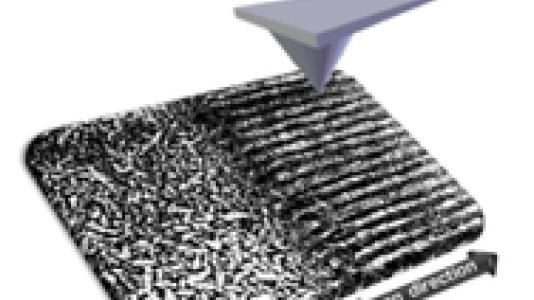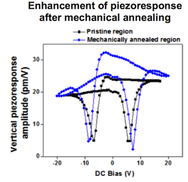
Scientific Achievement
We developed a nanoscale mechanical annealing process of polymer ferroelectric thin films, which can control nanoscale material properties and molecular orientation using intensive local stress.
Significance and Impact
Nanoscale mechanical annealing process can be used to improve and control the local material properties in the polymeric thin films and fabricate high performance piezoelectric devices.
High-Level Research Details
Our study involves a discovery of a novel mechanism that is able to overcome the previous limitations of developing ferroelectric polymer thin films with high piezoelectric properties. More specifically, we have developed a mechanical annealing process, which can control nanoscale material properties and molecular orientation using intensive local stress. We directly applied mechanical stress, which can induce irreversible plastic deformation, to P(VDF-TrFE) thin film using nanoscale tip at room temperature. Plastically deformed regions did not show any significant damage or delamination. Rather remarkably, the vertical and lateral piezoresponse amplitudes measured after the mechanical annealing were 28% and 102.4% higher than the pristine film in this study. In addition, randomly oriented lamellar crystals were well-aligned along the applied stress direction.
Additional Research Details
We report a mechanical annealing effect in the ferroelectric polymers induced by the SPM tip-generated stress, which results in enhancement of local piezoelectric response. Piezoresponse force microscopy imaging and Raman spectroscopy show that the mechanical annealing increases the volume fraction of the ferroelectric β-phase with a long chain sequence and aligns the in-plane component of polarization toward the direction perpendicular to the scan direction. We believe that this new technique can be used for enhancement of molecular alignment and piezoelectric property. In order to apply “mechanical annealing” to large-scale production of high performance piezoelectric device, we are currently developing techniques for scale-up using either a roller with multiple sharp tips or a macroscale razor blade with nanoscale sharpness.
Research Team
Yoon-Young Choi, Charudatta Phatak, Seungbum Hong (Argonne Materials Science Division), Pankaj Sharma, Alexei Gruverman, Stephen Ducharme (University of Nebraska, Lincoln), David J. Gosztola, Joonseok Lee (Argonne Center for Nanoscale Materials), Byeondu Lee (Argonne X-ray Science Division), Yunya Liu (Xiangtan University, China) and Jiangyu Li (University of Washington, Seattle).
Sponsors
U.S. Department of Energy, Office of Science, Argonne National Laboratory under Contract No. DE-AC02-06CH11357; Department of Energy, Office of Science, Office of Basic Energy Sciences User Facilities; National Science Foundation (NSF), Materials Research Science and Engineering Center (MRSEC) under Grant DMR-142064; NSFC (11102175); NSF, CMMI-1100339.
References
Y.-Y. Choi, P. Sharma, C. Phatak, D. J. Gosztola, Yunya Liu, J. Lee, B. Lee, J. Li, A. Gruverman, S. Ducharme, and S. Hong, ACS Nano 9, 1809 – 1919 (2015)
Acknowledgments
The authors gratefully acknowledge T. Wang for fabrication of Langmuir_Blodgett P(VDF-TrFE) films for X-ray measurement. The work of Raman spectroscopy, SEM and TEM imaging, and GIWAXS were performed at the Center for Nanoscale Materials, Electron Microscopy Center and Advanced Photon Source, a U.S. Department of Energy, Office of Science, Office of Basic Energy Sciences User Facilities, under Contract DE-AC02-06CH11357. The research at the University of Nebraska_Lincoln (PFM characterization and sample fabrication by P. Sharma, A. Gruverman, and S. Ducharme) was supported by the National Science Foundation (NSF) through the Materials Research Science and Engineering Center (MRSEC) under Grant DMR-1420645. Y.Y.L. acknowledges the support of NSFC (11102175), and J.Li acknowledges the support of the NSF (CMMI-1100339).
